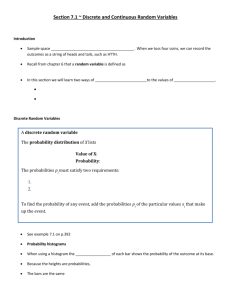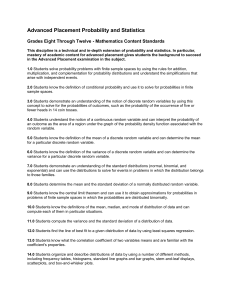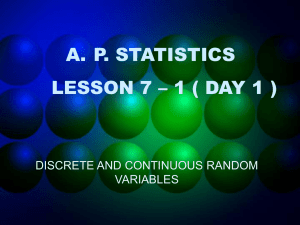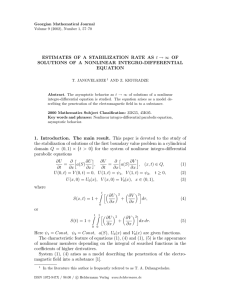Lecture 6 : The Normal Distribution
advertisement
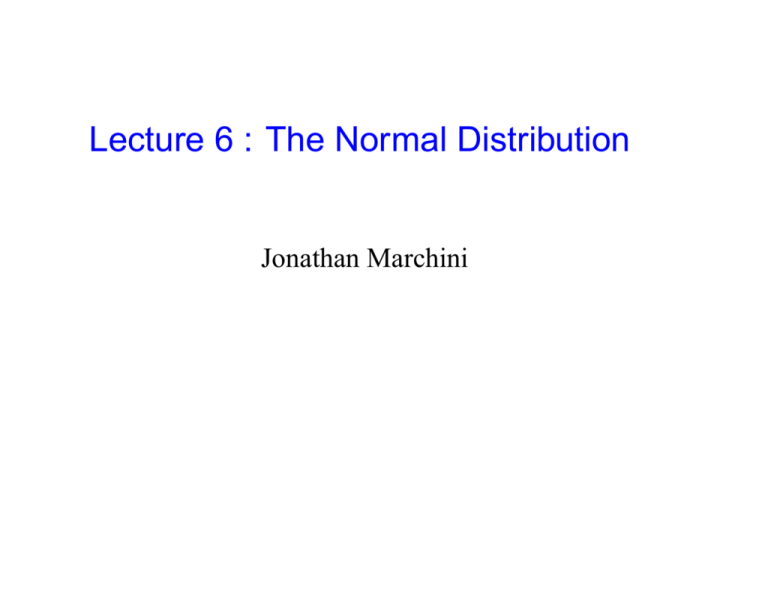
Lecture 6 : The Normal Distribution Jonathan Marchini Continuous data In previous lectures we have considered discrete datasets and discrete probability distributions. In practice many datasets that we collect from experiments consist of continuous measurements. So we need to study probability models for continuous data. 6 4 2 0 Frequency 8 10 The birth weights of the babies in the Babyboom dataset 1000 2000 3000 4000 Birth weight (g) 5000 6000 6 4 2 0 Frequency 8 10 The brain sizes of 40 students 700000 800000 900000 Brain size 1100000 8 6 4 2 0 Frequency 10 12 The petal length of a type of flower 1.0 1.2 1.4 Petal length 1.6 1.8 40 20 0 Frequency 60 Serum level measurements from healthy volunteers 0 100 200 Serum level 300 400 Continuous probability distributions When we considered the Binomial and Poisson distributions we saw that the probability distributions were characterized by a formula for the probability of each possible discrete value. All of the probabilities together sum up to 1. We can visualize the density by plotting the probabilities against the discrete values. 0.00 0.02 0.04 0.06 0.08 0.10 0.12 P(X) A discrete probability distribution 0 5 10 X 15 20 For continuous data we don’t have equally spaced discrete values so instead we use a curve or function that describes the probability density over the range of the distribution. The curve is chosen so that the area under the curve is equal to 1. If we observe a sample of data from such a distribution we should see that the values occur in regions where the density is highest. 0.02 0.01 0.00 density 0.03 0.04 A continuous probability distribution 60 80 100 X 120 140 The Normal Distribution There will be many, many possible probability density functions over a continuous range of values. The Normal distribution describes a special class of such distributions that are symmetric and can be described by two parameters (i) µ = The mean of the distribution (ii) σ = The standard deviation of the distribution Changing the values of µ and σ alter the positions and shapes of the distributions. 0.00 50 100 150 50 100 150 µ = 130 σ = 10 µ = 100 σ = 15 0.04 0.00 0.04 density 0.08 X 0.08 X 0.00 density 0.04 density 0.04 0.00 density 0.08 µ = 100 σ = 5 0.08 µ = 100 σ = 10 50 100 X 150 50 100 X 150 If X is Normally distributed with mean µ and standard deviation σ, we write X∼N(µ, σ 2) µ and σ are the parameters of the distribution. The probability density of the Normal distribution is given by 2 2 1 −(x−µ) /2σ f (x) = √ exp σ 2π For the purposes of this course we do not need to use this expression. It is included here for future reference. Calculating probabilities from the Normal distribution For a discrete probability distribution we calculate the probability of being less than some value x, i.e. P (X < x), by simply summing up the probabilities of the values less than x. For a continuous probability distribution we calculate the probability of being less than some value x, i.e. P (X < x), by calculating the area under the curve to the left of x. Suppose Z ∼ N(0, 1), what is P (Z < 0) ? P(Z < 0) 0 Symmetry ⇒ P (Z < 0) = 0.5 What about P (Z < 1.0)? P(Z < 1) 0 1 Calculating this area is not easy and so we use probability tables. Probability tables are tables of probabilities that have been calculated on a computer. All we have to do is identify the right probability in the table and copy it down! Only one special Normal distribution, N(0, 1), has been tabulated. The N(0, 1) distribution is called the standard Normal distribution. The tables allow us to read off probabilities of the form P (Z < z). 0 z z 0.0 0.1 0.2 0.3 0.4 0.5 0.6 0.7 0.8 0.9 1.0 1.1 0.0 0.5000 0.5398 0.5793 0.6179 0.6554 0.6915 0.7257 0.7580 0.7881 0.8159 0.8413 0.8643 0.01 5040 5438 5832 6217 6591 6950 7291 7611 7910 8186 8438 8665 0.02 5080 5478 5871 6255 6628 6985 7324 7642 7939 8212 8461 8686 0.03 5120 5517 5910 6293 6664 7019 7357 7673 7967 8238 8485 8708 0.04 5160 5557 5948 6331 6700 7054 7389 7704 7995 8264 8508 8729 0.05 5199 5596 5987 6368 6736 7088 7422 7734 8023 8289 8531 8749 0.06 5239 5636 6026 6406 6772 7123 7454 7764 8051 8315 8554 8770 0.07 5279 5675 6064 6443 6808 7157 7486 7794 8078 8340 8577 8790 0.08 5319 5714 6103 6480 6844 7190 7517 7823 8106 8365 8599 8810 0.09 5359 5753 6141 6517 6879 7224 7549 7852 8133 8389 8621 8830 From this table we can identify that P (Z < 1.0) = 0.8413 Example 1 If Z ∼ N(0, 1) what is P (Z > 0.92)? P(Z > 0.92) P(Z < 0.92) 0 0 0.92 0.92 We know that P (Z > 0.92) = 1 − P (Z < 0.92) and we can calculate P (Z < 0.92) from the tables. Thus, P (Z > 0.92) = 1 − 0.8212 = 0.1788 Example 2 If Z ∼ N(0, 1) what is P (Z > −0.5)? P(Z > −0.5) −0.5 0 P(Z < 0.5) 0 0.5 The Normal distribution is symmetric so we know that P (Z > −0.5) = P (Z < 0.5) = 0.6915 Example 3 If Z ∼ N(0, 1) what is P (Z < −0.76)? P(Z < −0.76) −0.76 0 P(Z < 0.76) 0 0.76 By symmetry P (Z < −0.76) = P (Z > 0.76) = 1 − P (Z < 0.76) = 1 − 0.7764 = 0.2236 Example 4 If Z ∼ N(0, 1) what is P (−0.64 < Z < 0.43)? P(−0.64 < Z < 0.43) −0.64 P(Z < −0.64) −0.64 0 0 0.43 P(Z < 0.43) 0 0.43 We can calculate this probability as P (−0.64 < Z < 0.43) = P (Z < 0.43) − P (Z < −0.64) = 0.6664 − (1 − 0.7389) = 0.4053 Example 5 Consider P (Z < 0.567)? From tables we know that P (Z < 0.56) = 0.7123 and P (Z < 0.57) = 0.7157 To calculate P (Z < 0.567) we interpolate between these two values P (Z < 0.567) = 0.3 × 0.7123 + 0.7 × 0.7157 = 0.71468 Standardization All of the probabilities above were calculated for the standard Normal distribution N(0, 1). If we want to calculate probabilities from different Normal distributions we convert the probability to one involving the standard Normal distribution. This process is called standardization. Suppose X ∼ N(3, 4), what is P (X < 6.2)? N(3, 4) 3 −3 => N(0, 4) 0 / 2 => N(0, 1) 0 1.6 3.2 6.2 We convert this probability to one involving the N(0, 1) distribution by (i) Subtracting the mean µ (ii) Dividing by the standard deviation σ Subtracting the mean re-centers the distribution on zero. Dividing by the standard deviation re-scales the distribution so it has standard deviation 1. If we also transform the boundary point of the area we wish to calculate we obtain the equivalent boundary point for the N(0, 1) distribution. ⇒ P (X < 6.2) = P (Z < 1.6) = 0.9452 where Z ∼ N(0, 1) This process can be described by the following rule If X ∼ N(µ, σ 2) and Z = then Z ∼ N(0, 1) X−µ σ Example 6 Suppose we know that the birth weight of babies is Normally distributed with mean 3500g and standard deviation 500g. What is the probability that a baby is born that weighs less than 3100g? That is X ∼ N(3500, 5002) and we want to calculate P (X < 3100)? We can calculate the probability through the process of standardization. Drawing a rough diagram helps X ~ N(3500, 5002 ) Z ~ N(0, 1) P(X < 3100) P(Z < −0.8) Z = X − 3500 500 3100 3500 3100 − 3500 0 500 = −0.8 X − 3500 3100 − 3500 < P (X < 3100) = P 500 500 = P (Z < −0.8) = 1 − P (Z < 0.8) = 1 − 0.7881 = 0.2119 ! where Z ∼ N(0, 1) Linear combinations of Normal random variables Suppose two rats A and B have been trained to navigate a large maze. X = Time of run for rat A Y = Time of run for rat B X ∼ N(80, 102) Y ∼ N(78, 132) On any given day what is the probability that rat A runs the maze faster than rat B? Let D = X − Y be the difference in times of rats A and B If rat A is faster than rat B then D < 0 so we want P (D < 0)? To calculate this probability we need to know the distribution of D. To do this we use the following rule If X and Y are two independent normal variable such that X ∼ N(µ1, σ12) and Y ∼ N(µ2, σ22) then X − Y ∼ N(µ1 - µ2, σ12 + σ22) In this example, D = X − Y ∼ N(80 − 78, 102 + 132) = N (2, 269) We can now calculate this probability through standardization D ~ N(2, 269) Z ~ N(0, 1) P(Z < −0.122) P(D < 0) Z=D−2 16.40 0 2 0−2 0 16.40 = −0.122 D−2 0−2 <√ P (D < 0) = P √ 269 269 = P (Z < −0.122) ! Z ∼ N (0, 1) = 1 − (0.2 × 0.5478 + 0.8 × 0.5517) = 0.45142 Other rules that are often used are If X and Y are two independent normal variables such that X ∼ N(µ1, σ12) and Y ∼ N(µ2, σ22) then X + Y ∼ N(µ1 + µ2, σ12 + σ22) aX ∼ N(aµ1, a2σ12) aX + bY ∼ N(aµ1 + bµ2, a2σ12 + b2σ22) Using the Normal tables backwards The marks of 500 candidates in an examination are normally distributed with a mean of 45 marks and a standard deviation of 20 marks. If 20% of candidates obtain a distinction by scoring x marks or more, estimate the value of x. We have X ∼ N(45, 202) and we want x such that P (X > x) = 0.2 ⇒ P (X < x) = 0.8 X ~ N(45, 400) Z ~ N(0, 1) P(X < x) = 0.8 P(Z < 0.84) = 0.8 Z = X − 45 20 45 x 0 x − 45 20 = 0.84 Standardizing this probability we get X − 45 x − 45 < P 20 20 ! = 0.8 x − 45 ⇒P Z< 20 ! = 0.8 From the tables we know that P (Z < 0.84) ≈ 0.8 so ⇒ x − 45 ≈ 0.84 20 x ≈ 45 + 20 × 0.84 = 61.8 The Normal approximation to the Binomial Under certain conditions we can use the Normal distribution to approximate the Binomial distribution. N(150, 75) 0.04 0.03 0.00 0.01 0.02 density 0.03 0.02 0.01 0.00 P(X = x) 0.04 Bin(300, 0.5) 100 120 140 160 X 180 200 100 120 140 160 X 180 200 In general If X ∼ Bin(n, p) then µ = np σ 2 = npq where q = 1 − p For large n and p not too small or too large X ∼ N(np, npq) n > 10 and p ≈ 12 OR n > 30 and p moving away from 12 Example Suppose X ∼Bin(12, 0.5) what is P (4 ≤ X ≤ 7)? For this distribution we have µ = np = 6 σ 2 = npq = 3 So we can use a N(6, 3) distribution as an approximation. Unfortunately, it’s not quite so simple. We have to take into account the fact that we are using a continuous distribution to approximate a discrete distribution. This is done using a continuity correction. 0 1 2 3 4 3.5 5 6 7 8 7.5 9 10 11 12 P (4 ≤ X ≤ 7) transforms to P (3.5 < X < 7.5) ! 3.5 − 6 X − 6 7.5 − 6 √ P (3.5 < X < 7.5) = P < √ < √ 3 3 3 = P (−1.443 < Z < 0.866) where Z ∼ N(0, 1) = 0.732 The exact answer is 0.733 so in this case the approximation is very good. The Normal approximation to the Poisson We can also use the Normal distribution to approximate a Poisson distribution under certain conditions. In general, If X ∼ Po(λ) then µ = λ σ2 = λ For large λ (say λ > 20) X ∼ N(λ, λ) Example A radioactive source emits particles at an average rate of 25 particles per second. What is the probability that in 1 second the count is less than 27 particles? X = No. of particles emitted in 1s X ∼ Po(25) So, we can use a N(25, 25) as an approximate distribution. Again, we need to make a continuity correction So P (X < 27) transforms to P (X < 26.5) X ~ N(25, 25) Z ~ N(0, 1) P(X < 26.5) P(Z < 0.3) Z = X − 25 5 25 26.5 0 26.5 − 25 5 = 0.3 X − 25 26.5 − 25 < P (X < 26.5) = P 5 5 = P (Z < 0.3) = 0.6179 ! where Z ∼ N(0, 1)



